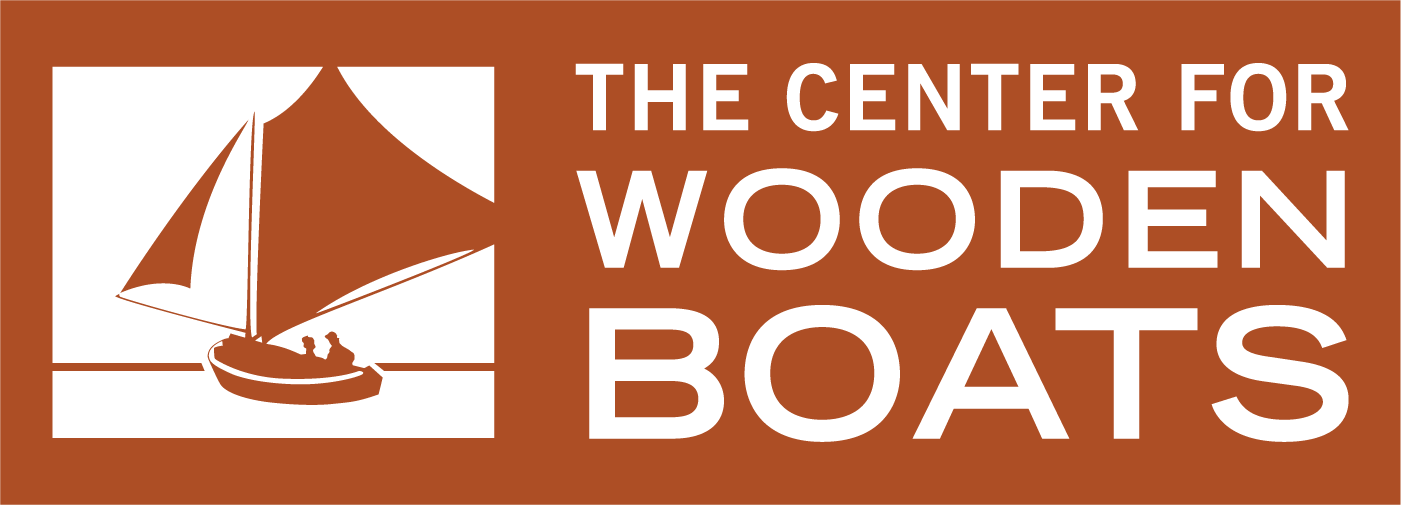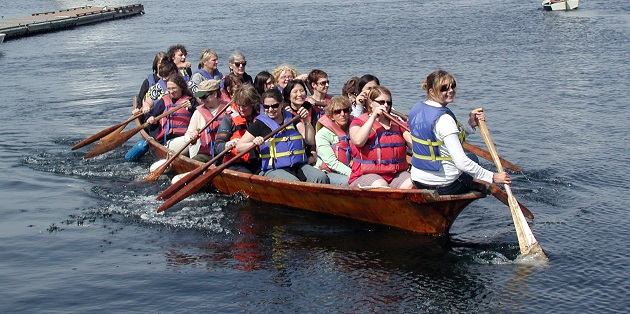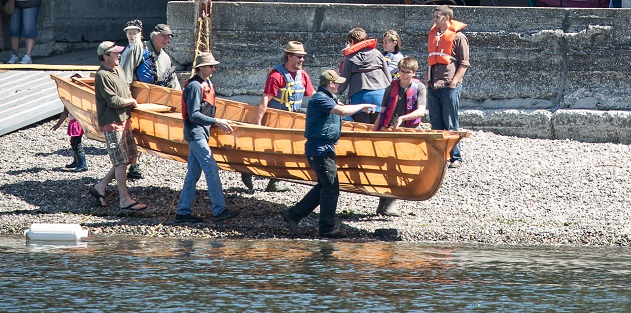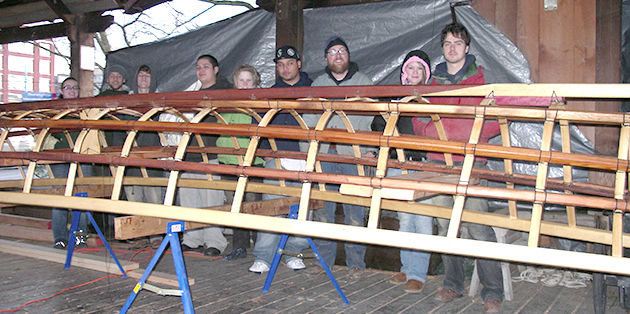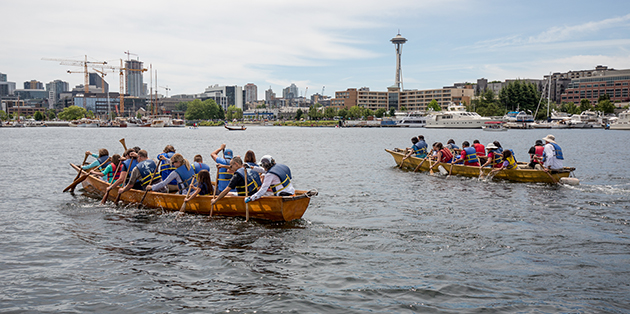Umiaqs
Nukka, built 2012
Aakura, built 2005
Umiaqs, sometimes spelled umiaks, are traditional workboats built by arctic peoples including the Inupiaq and Yup’ik cultures. They were used across the Arctic, from Siberia to Greenland, for thousands of years to transport both people and goods. Umiaqs can be paddled or sailed, and some were even fitted with outboard engines.
Our Umiaqs were built at CWB by students and workshop instructors, and are used in our youth and public programs. They can hold up to twelve adult paddlers, plus a steersman, or up to fifteen children for our field trips.
INTERESTING FACTS ABOUT UMIAQS
Umiaqs are built without nails, screws, or other fastenings. The frame is formed by lashing strips of wood together.
Traditionally, umiaqs were covered with walrus skin rubbed with whale or seal oil. Ours are covered with ballistic nylon, sealed with epoxy resin.
GET OUT ON OUR UMIAQS
Our South Lake Union Umiaqs Nuuka and Aakura are used in most of CWB’s South Lake Union Field Trip programs. LEARN MORE HERE
Nuuka and Aakura also go out on our CastOFF! Public Sail program during the summer season. LEARN MORE HERE
We have a third Umiaq at Cama Beach, used in public programs and for our Mother’s Day Sail. LEARN MORE HERE
If you’re interested in skin-on-frame boatbuilding, we offer a Baidarka-Building Workshop for adults periodically. Check back to see if we are offering it this year! Currently there is no baidarka-building workshop scheduled for 2020.
UMIAQ HISTORY
Umiaqs were traditionally used for hunting and moving from place to place. People first started making them about 5000 years ago. They were made by Arctic native people from North America, Canada, and Greenland. They are used mostly in places that are very far north like the coast of Siberia, the North American Arctic, especially the Aleutian Islands, and Greenland. They maneuver well when there are big waves. They usually carried 10 to 12 persons; but it only took 6 people to carry them around. The umiaq is still used today.
HOW UMIAQS WERE MADE
A traditional umiaq was made of a wooden frame covered with seal or walrus skins. Since there are no tall trees in the artic, they had to use what was available. The frame was generally driftwood. Builders liked to use female walrus skins to cover the boats because they were thinner, didn’t wear out as easily, and absorbed less water than male skins. The female’s skin is also wider (to fit around the frame more easily). Skins were replaced every 2 – 3 years. If there weren’t enough female walrus skins to recover a boat, a skin could be used for 4 or 5 years. If a frame was kept in good shape, it could last for 30 to 40 years.
Frames and the keel (a piece of wood running along the center of the bottom of the boat) were tied with tendons and leather strips usually made from young walrus skins. Nails were not used because they were too expensive, could rust, and caused the skins to rot. Driftwood from trunks of large spruce trees were used to make the 2 main center pieces – called the stem and the stern post. It took 2 of these trees per boat, one for each end. Driftwood from cottonwood or spruce was used for other smaller frames. At times whale bones were also used for frames. The upper ends of the frames were tied to gunwales (long pieces of wood called that formed the top edge), which also kept the thwarts (seats) in place. Wood was placed across the bottom so people could stand on it or load things on top of it. Most umiaqs were 22 to 33 feet long and about 5 feet wide, but some could be up to 50 or even 60 feet long. Sometimes there were ivory runners on the bottom of the boat to protect the skin when the boat was slid over ice. Skins exposed to the sun for a long time would dry out and crack. Often they rubbed the boat with seal, walrus, or even whale oil. Sometimes the umiaqs had also a small mast on the bow with a square sail made from reindeer skins.
WHAT UMIAQS WERE USED FOR
Some groups followed animal migrations. They used umiaqs to move a family’s things, children, and people that were too sick or old to paddle. The women of the village paddled the umiaq while men paddled kayaks. In these cultures umiaqs are called “women boats”. In other groups umiaqs were used primarily for hunting seal, walrus, and whale. In these groups, the umiaq was usually paddled by men. Whale hunting has important cultural meanings and is part of an ancient tradition. Because their diet consisted primarily of meat, they would not have survived without hunting. In Inuit legends, humans and whales were friends. Since a whale could feed many people for months, whales were a symbol of the harmony of humans and nature. It was believed the spirit of a hunted whale returned to the water and was reborn. Whales were hunted using harpoons. After a whale had been harpooned, a hunter jumped onto its back and then sewed up its mouth so it wouldn’t sink. The whales were either pushed to land by the wind and current or if they were small towed in. The whalers carried waterproof ‘jumping furs’ made of seal skins turned inside out. They could be inflated and were used to protect a hunter against the cold water while on the whale’s back. In the fall, when ice was beginning to get thick at the edges of the water, a crew member would hold a paddle against the edge of the boat to avoid wear and tear on the skin or if the crew knew conditions were particularly bad before they left the village they would take an old skin and hang it on the front of the boat to protect it. Or a walrus skin could be tied in place, usually with the blubber side out. Often a layer of ice up to ¾” thick would form on the boats.
HOW UMIAQS HAVE CHANGED
Umiaq construction changed in the 1920’s. In these boats driftwood is replaced with wood that has been bent by heating it up with very hot water. The frames are now made with oak, hickory, yellow or red cedar, and/or Douglas fir. The outside is made out of polyurethane coated nylon instead of skins. We used chopsticks to bolt CWB’s Umiaq together. Other wooden parts like thwarts (seats), stern-post and stems, and keel are made of almost any kind of wood that is the right size. A “false” keel (thick wood strip along the bottom center) on the outside usually replaces the runners.
ADDITIONAL LINKS
The Skin Boat Store, source of parts, kits, and information on contemporary umiaqs LINK
